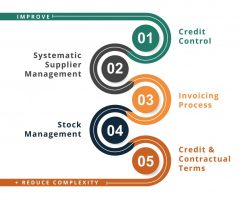Why revenue is vanity and cash is king

Revenue is vanity
Growing the size or revenue of business is not always a good thing. In this section we are going to explore some of the reasons for this. Let’s go through some of the good points of larger companies.
The pros:
Firstly, larger companies are less likely to fail than smaller companies. They usually have more resources to fall back on if things do go wrong. Therefore, as employees and management teams, we have more job security being part of a larger organisation.
Secondly, to get to be a large company organically, you have found a business model that works. This gives you an advantage to out-compete most of your peers. We are all proud to be associated with success. We have a very human desire to be part of large social groups with the social status and protection this confers. As individuals, we gravitate towards larger businesses as a result.
Unsurprisingly, many gravitate towards larger companies because of the above.
The cons:
In contrast, we have come across many large businesses that are not very strong. They have little margin for error in their operations, low profitability or lots of debt. If the company pursues size rather than quality, it can end up in this category.
A great example is Carillion – a large business that put size before everything else. Carillion group grew through a series of acquisitions to become the second largest construction company in the UK. It listed on the LSE in 2016. In 2018 Carillion became “the largest ever trading liquidation in the UK”. If Carillion had focused more on quality, the result may have been different.
Another example of chasing revenue was the dot-com period of up to 2002. The Dot-com companies chased revenue with little regard to profits or cash generation. The tech sector today still has a winner take all dynamic. Many companies are pushing hard for market share, with investors’ cash, in the hope of outlasting the competition and gaining dominance. Recently, there has been investor pressure pushing the focus towards making profits.
Lastly, growing businesses typically need cash to continue growing. Do they create that themselves or ask investors for regular cash injections? There is currently a lot of money available for investment, but how long will this last if another downturn starts? A company pursuing only growth, without generating cash, has a high risk of failure in this scenario.
In conclusion, there is a lot of truth in the saying that “Revenue is vanity”. Revenue alone does not pay your wages nor fund growth.
Profits are great for keeping score and setting bonus targets
Let’s explore profits, the standard measure of company success. Profits are a great metric for keeping score. Every activity or project that you do within the company will have an impact on the profit that you make.
Let’s look at some examples:
Add another salesperson, and you increase your costs with the hope of increasing your sales by a larger amount. Undertake a marketing campaign and costs go up. Again with the hope of increasing your future sales by more.
In management courses, we are taught that profits are important. Everyone working in a business understands that being profitable is good and loss-making is bad. It is a widely understood concept. This and the fact that everything impact profits, makes profit a great and common metric for employee bonuses. As a result, what happens after we have earned our profits receives considerably less attention.
Unfortunately, there is limited understanding of the relationship between profits and cash by most employees. As a result, the hard work of turning those profits into cash receives a lot less attention within most businesses from management teams.
Finally, profits are a theoretical financial measure. They are not real. Profits are great for keeping score, but you can’t buy a new factory with “profits” – you need cash.
Profits are not cash
Many people think that profits are pretty much the same as cash. Astute business people understand that this is not the case.
There is a journey between earning accounting profits and generating cash. This journey is not a simple one. The details of this journey are not widely taught outside finance professionals.
In some businesses, cash and profit can be quite different in any given financial period. The main factors that create differences between profit and cash include:
- Capital expenditure – on machinery, offices, factories
- Working Capital – stock, debtors (what people owe you) and creditors (what you owe others). To learn more about managing Working Capital click here
- Investing activities – debt repayments and issuance, and share buy backs and share issuance
“More companies die from indigestion than starvation” is a sad fact. There are many companies that are profitable and still fail. This is because they may be great at earning profit but maybe not good at managing working capital. As a result, they run out of cash and fail.
Therefore, “profit is sanity” is a good saying because profit is significantly further along the journey to generating cash than revenue.
Why cash generation will always be king
Increasing cash is the absolute measure of a successful company. Apple, Berkshire Hathaway and Google have well published cash mountains, and these continue to grow. These businesses have world dominating business models and their cash mountains are a result of this success.
You can buy things with cash: invest in the next marketing campaign, hire a new employee, invest in future growth. Cash has a lot of value. Profit is just an accounting measure and pretty worthless in isolation.
In conclusion, Cash is King!
Don’t get caught with a profitable business that has not managed it working capital (stock, debtors and creditors) well. Make sure you have visibility and focus on all activities and projects until you have the cash in your bank account.
Good businesses keep a focus on all three – revenue, profit and cash. You need revenue to be able to make a profit, and profit to be able to generate cash.






